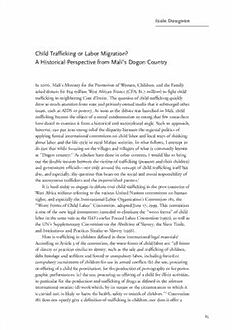Table Of ContentIsaie Dougnon
Child Trafficking or Labor Migration?
A Historical Perspective from Mali’s Dogon Country
In2000,Mali’sMinistryforthePromotionofWomen,Children,andtheFamily
askeddonorsfor824millionWestAfricanFrancs(CFA;$1.7million)tofightchild
traffickinginneighboringCoted’Ivoire.Thequestionofchildtraffickingquickly
drewsomuchattentionfromstateandprivatelyownedmediathatitsubmergedother
issues,suchasAIDSorpoverty.AssoonasthedebatewaslaunchedinMali,child
traffickingbecametheobjectofamoralcondemnationsostrongthatfewresearchers
havedaredtoexamineitfromahistoricalandsocioculturalangle.Suchanapproach,
however,canputintostrongreliefthedisparitybetweentheregionalpoliticsof
applyingformalinternationalconventionsonchildlaborandlocalwaysofthinking
aboutlaborandthelifecycleinruralMaliansocieties.Inwhatfollows,Iattemptto
dojustthatwhilefocusingonthevillagesandvillagersofwhatiscommonlyknown
as‘‘Dogoncountry.’’Asscholarshavedoneinothercontexts,Iwouldliketobring
outthedoubletensionbetweenthevictimsoftrafficking(peasantsandtheirchildren)
andgovernmentofficials—notonlyaroundtheconceptofchildtraffickingitselfbut
also,andespecially,thequestionthatbearsonthesocialandmoralresponsibilityof
theanonymoustraffickersandtheimpoverishedparents.1
Itishardtodaytoengageindebateoverchildtraffickinginthepoorcountriesof
WestAfricawithoutreferringtothevariousUnitedNationsconventionsonhuman
rights,andespeciallytheInternationalLaborOrganization’sConvention182,the
‘‘WorstFormsofChildLabor’’Convention,adoptedJune17,1999.Thisconvention
isoneofthenewlegalinstrumentsintendedtoeliminatethe‘‘worstforms’’ofchild
laborinthesameveinastheILO’searlierForcedLaborConvention(1930),aswellas
theUN’sSupplementaryConventionontheAbolitionofSlavery,theSlaveTrade,
andInstitutionsandPracticesSimilartoSlavery(1956).
Howistraffickinginchildrendefinedintheseinternationallegalmaterials?
AccordingtoArticle3oftheconvention,theworstformsofchildlaborare:‘‘allforms
ofslaveryorpracticessimilartoslavery,suchasthesaleandtraffickingofchildren,
debtbondageandserfdomandforcedorcompulsorylabor,includingforcedor
compulsoryrecruitmentofchildrenforuseinarmedconflict;(b)theuse,procuring
orofferingofachildforprostitution,fortheproductionofpornographyorforporno-
graphicperformances;(c)theuse,procuringorofferingofachildforillicitactivities,
inparticularfortheproductionandtraffickingofdrugsasdefinedintherelevant
internationaltreaties;(d)workwhich,byitsnatureorthecircumstancesinwhichit
iscarriedout,islikelytoharmthehealth,safetyormoralsofchildren.’’2Convention
182doesnotopenlygiveadefinitionoftraffickinginchildren,nordoesitoffera
85
.................17987$ $CH7 02-14-1115:51:21 PS PAGE85
MAURITANIA
MALI
NIGER
SENEGAL
Dogon Country
THE GAMBIA
Bamako
•
BURKINA FASO
GUINEA
BENIN
GUINEA-BISSAU
NIGERIA
SIERRA LEONE
GHANA
IVORY COAST
Kumasi
LIBERIA •
Accra
•
TOGO
0 200 400 600 km
0 100 200 300 400 mi
Figure1:MapofContemporaryWestAfricawithDogonCountry
specificapproachtothisphenomenon,whichisexplicitlymentionedinArticle3(a):
‘‘allformsofslaveryorpracticessimilartoslavery,suchasthesaleandtraffickingof
children.’’InadditiontoConvention182,thereisalsotheConventionontheRights
oftheChild(1989),Article35ofwhichcondemns‘‘theabductionof,thesaleofor
trafficinchildrenforanypurposeorinanyform.’’If‘‘traffickinginchildren’’isleft
withoutexplicitdefinition,traffickingistakenupintheUNProtocoltoPrevent,
SuppressandPunishTraffickinginPersons,EspeciallyWomenandChildren,supple-
mentingtheUnitedNationsConventionagainstTransnationalOrganizedCrime
(2000).Itscrucialarticlerepeatstheworstformsalreadymentionedinthetwoearlier
conventionsandinnumerousotherdocumentsnegotiatedininternationalconfer-
ences.3
Whateverdefinitionisgivenineachofthesedocuments,traffickingappearsasa
phase—andthemostodious—ofthecycleofexploitationofchildrenaswellasadults,
anditdemandstheurgentactionoftheinternationalcommunity.Thephenomenon
isdeclaredtobeaglobaloneandnocountryisspared,whetherasasource,transit
point,ordestinationoftraffickedchildren.TheILOestimatesthatmorethanten
millionadultsandchildrenaresubjecttosomeformofforcedlabor,bondedlabor,
orcommercialsexualservitudeatanygiventime,whileUNICEFestimatedin2004
thattraffickinginchildrenaffectedapproximately1.2millionchildreneachyear.4
Allthesignatorycountriesoftheconventionstargetingchildtraffickingarecalled
upontodevelopnationalprogramsaimedtoeliminateitonceandforall.Convention
182specifiesthattheseprogramsareintendedtofunctioninconsultationwithpublic
86 Humanity Spring2011
.................17987$ $CH7 02-14-1115:53:05 PS PAGE86
institutionsandorganizationsofemployersandworkers,ifnecessary,bytakingthe
viewsofotherinterestedgroupsintoconsideration.
Ifthisglobaldiscourseofchildtraffickingisproducedandpopularizedfrom
Geneva,hereIexaminehowitistakenupbystateofficialsinMali.Isitapplied
mechanicallyoraccommodatedconceptuallytolocalhistoricalandsocialrealities?
Howhavethewords‘‘traffic’’and‘‘work’’beentranslatedintootherlanguages?To
whatdegreehaveconcernedgroupsandinterestedparties—peasantparentsof
workingchildrenontheonehandandurbanheadsofhouseholdswhoaretheir
principalemployersontheother—beeninvolvedinthecampaign,ascalledforin
Convention182,Article3?Anethnographicandhistoricalapproachtotherelationship
betweendomesticlaborandpaidlaborinanAfricanpostcolonymayprovideaway
toanswerthesequestions.
InseveralnotesoftheILO’sInternationalProgramontheEliminationofChild
Labor,Maliwastargetedasoneofthecountrieswherechildtraffickingsurpassed
expectations.Infact,Maliisgenerallyconsideredtopresentalltheeconomicand
geographicconditionsfavoringtraffickingonalargescale.Meanwhile,Mali’spolitical
context,characterizedsince1991byaprocessofpeacefuldemocratization,favorsall
debatesthattouchonhumanrights.Infact,inademocraticfever,Malievencreated
in1992anephemeralMinistryforHumanRights.Humanrightsarecostlyina
countrylikeMali,andpeopleaskedthemselveshowaMinistryforHumanRights
couldsurviveinMaliifglobalinstitutionsgaveitnofunds.
ButitisnotonlypoliticalconditionsthatmakeMaliaprivilegedsiteofdebate
andactionaroundchildtrafficking.Onemustalsoconsidertheeconomic,demo-
graphic,andhistoricalcontext.In2006,thecountry’spopulationwasover12million,
witha2.2percentannualgrowthrateandanaveragepopulationdensityof7.9inhabi-
tantspersquaremile.About73percentofMali’scitizensliveinruralsettingsand
nearly50percentareunderfifteenyearsold.Withagrossnationalproductpercapita
of$268,Maliisamongthepoorestcountriesintheworld,accordingtothe2009
reportoftheUNDevelopmentProgram—inwhichMaliisranked178thofthe182
surveyednations.5
Forthesereasons,Malihasbeenacountrywithhighemigrationtoitsneighbors
forseveraldecades.Thepointisnottosimplydismissconcernforchildtraffickingas
paternalisticbuttoenrich,asLawrenceCohenhasargued,thecontextualsensitivity
tothesituationofthosewhoengageinthestigmatizedactivity.Economicindigency
willnotdisappearbecauseofmoralorlegalnorms,andtherelativerisksandbenefits
of‘‘trafficking’’—includingthequestionofavailablealternatives—mustalwaysbe
keptinview,asaconsiderableliteratureonthephenomenonsuggests.6
Butthereisalsoacrucialperspectiveontraffickingaffordedbyanapproach
combiningethnographyandhistory.Fordemographicandhistoricalreasons,thereis
nowaytoseparateadiscussionoftheworstformsofchildlaborfromthehistoryof
ruralmigrationpatterns.Onlyafewyearsago,demographersweredeeplyconcerned
withthemigrationofthepeasantrytotowns,butaconcernwithchildtraffickinghas
takentheplaceofthisfocus.Currently,itisestimatedthat,withinthreetofive
decades,60to70percentofAfricanswillliveinurbansettings.Thequestionbecomes
whatsortofcitytheywillhave.AsGunnarMyrdalobservedin1972,‘‘Urbanization
Dougnon:ChildTraffickingorLaborMigration? 87
.................17987$ $CH7 02-14-1115:53:05 PS PAGE87
isthusmoreareactionagainstthelackofvigorouseconomicgrowththanaresponse
torisinglevelsofincomeperhead.Indeed,muchofitisduetofactorsinhibiting
economicdevelopment,suchascivilwars,instability,andcropfailures,aswellasto
excessiveratesofpopulationgrowth.’’7InMalithisdevelopmentgrowsonlymore
obviouseachyear,withthedecliningproductionofcottonandcereals.Inthevillages,
hungerisnotamemorybutacyclicalfamiliarity.Themovementofyoungpeasants
totheurbancentersobservedforfortyyearsinthecountriesoftheGreatLakesregion
aswellasinthoseofWestAfricaismostlyevidenceofruralpoverty,insecurity,civil
wars,politicalinstability,andexcessivedemographicgrowth,thoughitisalsolinked
toinitiationandritual.8
Indeed,themovementofyoungAfricanshasreachedEurope,inspiteofphysical
andlegalbarrierserectedagainstthem.Infact,thedebateaboutchildtraffickingis
alsoinseparablefromtheproblemoftherightsofimmigrantandundocumented
workers,bothontheAfricancontinentaswellasinEuropeandtheUnitedStates.
Allso-calledirregularmigration,whethermajororminor,islikelytobeunderstood
astheproductofanetworkoftraffickersbasedontheMediterraneancoastsandwith
far-flungconnectionstothecountriesoftheSahel(Mali,Mauritania,andSenegal,in
particular).Thisjustifies,inpart,thehardeningofmeasuresofexpulsionandimpris-
onmentof‘‘irregular’’migrantsandtherelentlesspursuitofthosewhosmugglethem.
MaliappearstotheEuropeanUnionasthecountrywherebothmigrantsandsmug-
glersaremostprominent.TherecentcreationoftheMigrationInformationand
ManagementCenter(Centred’InformationsetdeGestiondesMigrants,CIGEM),
basedinBamakobutfundedbytheEU,atteststothisfact.Theconnectionbetween
thefearofaninvasionofworkersfrompoorcountriesandtheproblemofchild
trafficking(ortraffickingingeneral)isobvious.Itisonereason,amongothers,forthe
financingbywealthycountriesofnumeroussocialscientificstudiesthatfocusonthe
connectionbetweentraffickingandmigration,onthepremisethattraffickersexploit
thedifficultconditionsinwhichbothchildandadultmigrantsfindthemselvesin
theirsearchforwork.
Inkeepingwithsuchinitiatives,theMinistryfortheProtectionofWomen,
Children,andFamiliesdevelopedanationalplanfor2001–2020tocombatseveral
formsofchildtrafficking.Fortheexecutionofthisplan,thegovernmentcreatedan
administrativeandinstitutionalframeworkwhichinvolvedseveralministriesandcivil
societygroups.9EachministryandNGOwascharged,accordingtoitsspecialization,
withresponsibilityforoneformoftrafficinchildren.Forexample,theMinistryof
LaborandEducationaddresses‘‘children’slabor.’’TheMinistryofYouthwasdirected
totakechargeofthecriminalaspectsofthetrafficinchildren.TheMinistryofTerri-
torialAdministrationandCommunitiessupervisesquestionsrelatedtothecirculation
andsafetyofchildren.OnJune23,2000,anationalcommitteewasformedand
instructedtoexamineandevaluatethenationalplanofactionforthesurvivalof
children.Tothiscommittee,alongsideministryofficials,NGOrepresentativesand
developmentpartnerswereappointed.Inadditiontothevariousministries,for
example,anationalNGO,theMalianCoalitionforChildren’sRights(COMADE),
hadaseat.
Whatifsuchinternationalinquiriesandtheirnationalreflectionsweretotake
88 Humanity Spring2011
.................17987$ $CH7 02-14-1115:53:07 PS PAGE88
accountofthevoicesofmigrantsorchildrenalongtheway?Whatversionofthefacts
wouldtheygive?Intheirveryzealtoaidthem,acomplexofthestateandcertain
NGOsandassociationshasliterallysubstituteditselfforthesepoorchildmigrants
andtheirparents.Tobespecific,letustakethecaseofDogoncountry,which
accordingtoofficialdocumentsoftheServicedude´veloppementsocialetdel’e´co-
nomiesolidaireisoneofthezonesmostdisposedtochildtrafficking.10Theethnog-
raphyoftheruralexodusfromtheDogoncountry,togetherwiththehistoryoflabor
organizationinthecolonialera,providescriticalperspectives.
EthnographyandHistoryasWindowsonChildTrafficking
First,wemustclearlydefinetheobjectatthecenterofouranalysis:untilwhatageis
oneachild,andwhatisitthatwemeanbythephrase‘‘childtrafficking’’?UNICEF
expertsconsideranyoneundereighteenyearsofagetobeachild.AndMali’sNational
MinistryforthePromotionofChildrenandtheFamilygivesthefollowingdefinition
of‘‘childtrafficking’’:
Childtraffickingisdefinedasanyactinvolvingtherecruitment,transport,transfer
(fencing),orsaleofchildrenwithinnationalboundariesorabroad.Childtraf-
fickinghasmultipleresults:sexualexploitation,adoption,labor,criminalactivities,
begging,armedconflict,sports,marriage,andorgantrafficking.11
CivilservantsandNGOworkershavedrawndonors’attentiontothesocialand
ethicalaspectsoftheproblem,arguingthatchildtraffickingisa‘‘newformofslavery’’
andshouldbebanned.TheregionsofSikassoandSeguandtheDogoncountryhave
beencitedaszonesdisposedtowardchildtrafficking.TheBamana,Senoufo,and
Dogonethnicitiesareoftencitedasbeingaffectedbytrafficking.Nongovernmental
organizations,governmentadministrators,andlawenforcementagenciesholdforums
todiscusssolutionstothisscourge;afewpeasantsareinvitedtotheseconferencesas
well.12
TheDogoncountry,accordingtotheministry’sfindings,isthezonewherechild
traffickingisthemostintense.ThecerclesofBankass,Koro,Douentza,andBandiagara
supply‘‘bargainchildren’’totheCoted’Ivoire,Sikasso,Bamako,andMecca,inSaudi
Arabia.AccordingtotheBritishconsulateinMali,13adocumentaryonchildtraf-
fickinginDogoncountrythatwasshownintheUKsparkedtheindignationof
MalianslivinginLondon.SomeofthemsworethatMali’sDogonarenotcapableof
suchatrocities,particularlyinrelationtotheirownchildren.
Indeed,tosubmittodonorsareporttitled‘‘ChildTraffickinginDogonCountry’’
istosuggestthatDogonpeasantstakepartinthistrafficinonewayoranother.In
anycase,thiswastheexamplepresentedtotheBritishpublic.Butdoesasystemof
recruitment,transport,transfer,andthesaleofchildrenfromtheDogoncountryto
otherMaliancitiesortotheCoted’Ivoirereallyexist?Ifso,doDogonpeasantsplay
aroleinthistrade?Thereisnotasinglepieceofhistoricalevidencetosupportthe
argumentthatparentsareinvolvedinthesaleoftheirchildren.Theinadequaciesof
officialdefinitionsofchildlaborinlocalcontextsresultinpartfromthefactthatin
Malianvillagesthereisnodistinctionbetweendomesticlaborandthetypeoflabor
performedforwagesintownsandcities,asChanrasekhardemonstrateswithreference
Dougnon:ChildTraffickingorLaborMigration? 89
.................17987$ $CH7 02-14-1115:53:08 PS PAGE89
tochildlaborinIndia.14Thatbeingthecase,whywouldn’tachildwhoworksinthe
villagedothesameintown,orelsewhere?
Examiningthequestionofchildtraffickingfromanhistoricalandanthropological
perspective,whiledrawingonthetestimonyofmigrantsandoncolonialarchives,
allowsonetoavoidmakingthesameanalyticalerrorsasthosewhoheraldthereturn
ofbarbarisminAfrica.Weshouldinterrogateboththecolonialpastandthepresent
ofmigration,whilescrutinizingtherelationshipbetweenthecitiesandthecoun-
tryside.Inordertodoso,Ibasemyanalysisonmaterialcollectedbetween2001and
2003amongmigrantsfromDogoncountryinGhanaandinthevastirrigatedzone
knownastheOfficeduNiger,amongmigrantswhohavereturnedtoDogoncountry
afterasojourninthecitiesoftheWestAfricansubregion,andamongthosewhohave
neverleftthevillage.Tothequestion‘‘Howdidyoucometosellyourchildren?’’
peasantsgavethefollowingresponse:
No,thereisnotrafficinchildrenatBankass.It’stheNGOswhosaythatthereis
atrafficandthattheyaregoingtohelpustofightit.Whatwe’veknownsince
the‘‘timeoftheWhites’’[colonization]istheruralexodus,orthemigrationof
theyouth.Ifthereisatrafficinchildren,itisinthecountrywhereourchildren
go,andnothere[cheznous].
ThiskindofNGOdiscourse,socommonsincethe1980sinregardtoAfrica,takes
placeinthecontextofthechangingfocusofdevelopmentprojects:genitalmutilation,
organtrafficking,childlabor,therightsofwomenandchildren,nationalsolidarity
programs,andsoon.15
Onecoulddeducefromthedefinitionof‘‘childtrafficking’’thatifaboyoragirl
youngerthaneighteenmovestoanewsettingmoreorlessdistantfromhisorher
birthvillage,thisistheeffectoftrafficking.16Butateighteenyearsold,isonereallya
childinaMalianvillage?Thisfalsedefinitionofthe‘‘predicament’’meansthattalib´es,
orstudentsinQur’anicschools,aresuddenlydesignatedasvictimsoftrafficking.17
ArethepeasantswhoentrusttheirchildrentoQur’anicschoolteachersunawareofthe
factthattheywillbeexposedtomisery,deprivation,exploitation,andthedishonesty
oftheteachers?
Leavingasidethetalib´es,theyoungbeggars,andthechildrenusedbyadult
beggars,seasonalorpermanentmigrationispracticedbyyoungmenoffourteento
thirtyyearsofageandbygirlsoryoungwomenthirteentoeighteenyearsold.18They
themselvesdecidetoleave.Apeasantwouldhaveahardtimeforbiddinghissonor
daughtertotakepartinwhatisconsideredtobeavillagetradition.Manyfamily
headsdonotevenknowthedestinationstheirchildrenhavechosen.Theymayhave
soughttodissuadethembytellingthemthattheyareleavingforregionswheretheir
predecessorswereshamelesslyexploited,andfromwhichtheyreturnedpoorerthan
whentheyleft,buttheyoungpeopleleaveallthesame.Theirparentshavenopower
overthem.Onefineday,theysimplyleave,withoutinforminganyoneatall.Some-
timesasmanyastwentyyoungpeopleleaveavillageonthesameday.Howthencan
onetalkaboutatrafficinchildreninthezoneofdeparture?Infact,manypeasants
wereshockedtohearallegationsthattheywereinvolvedinthesaleoftheirchildren
90 Humanity Spring2011
.................17987$ $CH7 02-14-1115:53:11 PS PAGE90
to‘‘labormerchants.’’Accordingtothepeasants,theveryideaisaninsultmanufac-
turedbycertainNGOsinsearchoffunding.
Infact,thefirstproblemoneconfrontsinattemptingtoanalyzethequestionof
thetraffickingofMalianchildrenistheabsenceoftrustworthystatisticsthatdistin-
guishbetweenchildrenwhohavearrivedinthecityvoluntarilyandthosewhohave
actuallybeensold.StudiescarriedoutinDogoncountry,inSikasso,andintheCote
d’Ivoireweredonesoquickly—inordertostarttheflowoffundingtoopposethe
traffic—thattheirreliabilityissuspect.TheMinistryforthePromotionofWomen,
Children,andtheFamilyestimatesthatasmanyas15,000Malianchildrenareillegally
exploitedintheCoted’Ivoire.Thesechildrencomefromthemostimpoverished
regions,intermsofeconomicandeducationalinfrastructure.In2001,of523repa-
triatedchildren,128werefromtheregionofMopti,including92childrenfrom
Bankass,inDogoncountry.19Thus‘‘trafficking’’becomesasurvivalstrategyforpoor
ruralfamilies.
Theideaof‘‘childtrafficking,’’asdefinedabove,limitsthediscussiontothemost
easilyvisibleaspectoftheproblemofthemigrationofyoungpeople.Thisaspectof
migrationisnotspecifictoMaliortoanyotherAfricancountry.Indeed,certain
formsofsuffering—deathinthecourseofthevoyage,illegaldetention,forcedlabor,
torture,discrimination,prostitution,criminality,theabsenceoflibertiesandlegal
protections—areattheheartofthediscussiononglobalizationandmigrationin
SoutheastAsiaduringtheperiodofthe‘‘economicmiracle.’’20Thesameistruein
WestAfrica,whereyoungpeoplewithaburningdesiretoleaveforthecitytowork
inordertomeettheirpersonalneedsandthoseoftheirfamiliesfallintotrapslaidby
unscrupulousemployersandtheircriminalintermediaries.
Considerthesituationofthoseminorsinurbancenterswhoaredubbed‘‘appren-
tices.’’Althoughtheyarenotconsideredchildlaborersbythevariousorganizations
fightingthatscourge,theyarelegioninallfamilybusinesses,rangingfromautorepair,
construction,andcommercetomasonry,garmentwork,soapmanufacture,carpentry,
urbanandintercitytransport.A1962lawoutliningaCodeofLaborintheRepublic
ofMaliattemptedtogoverntheconditionsoftheapprenticeshipcontract.Article4
ofthelawstates:
Thecontractofapprenticeshipisonethroughwhichaperson,calledthemaster,
undertakestogiveorhavegiventoanotherperson,calledtheapprentice,a
methodical,progressive,andcompleteprofessionaltraining.Throughthiscontract
theapprenticeisobligated,inexchange,tofollowthedirectionthathereceives
andtofulfillthetasksthatareaccordedhimasanapprentice.21
Itisworthnotingwhatthelawsaysabouttheageoftheprospectiveapprentice.
Article5statesthat‘‘noapprenticecanbecontractedunlessheisatleast14yearsold.’’
AndArticle21coversthecaseofchildrenyoungerthanfourteen,whichistosay
minors,inspecifyingthat‘‘acontractoflaborconcludedwithaminorisnotvalid
unlessithasbeenapprovedinwritingbyhisfather(orthepersonexercisingpaternal
authority)andunlesstheminorhasnoschoolobligations.’’
Bymentioningtheword‘‘minor’’thelawtakesaccountofasocialrealitythat
Mali—lackinguniversaleducation—hasnomeanstoforbidorcondemn.Thelegis-
Dougnon:ChildTraffickingorLaborMigration? 91
.................17987$ $CH7 02-14-1115:53:11 PS PAGE91
latorsof1962knewthatchildrenbeganapprenticeshipsbetweenfourandsevenyears
ofage.Today,hundredsof‘‘workingtoddlers’’canbeseeninalltheworkshopsof
Bamako.Further,thelawstipulatesthatthecontractsmustbewritteninFrench.In
practice,thereisnocontract.Theparentsoftheminors,oftendestitute,arequite
simplypleasedtoseetheirchildrenlearnatradethatwillallowthemtofilltheir
bellies.Manychildrenwhowanderthestreetsdonotevenhavethisopportunity.Of
whatcontractcanonespeakwhenneitherthemasternortheparentsofthechild
knowshowtoreadandwrite?Thelawfixesatrialperiodofthreemonthsandthe
apprenticeshipitselfatfouryears.Heretoo,thefactsshowthattheapprenticesremain
withtheirmastersorleavethembehinddependingonwhetherornottheyfeelable
togetalongwithoutoriftheysimplyfeelfedup.Onthewhole,thelawdefends,for
betterandworse,theinterestsofbothminorandnon-minoryouth.Butineveryday
practiceofapprenticeshipinthelargecitiesofMali,theonlyclauseoftheappren-
ticeshipcontractisthemoodofthemaster.
Justaschildreninthepoorneighborhoodsofwhatarenowpostcolonialurban
centershadthepossibilityofenteringintoanapprenticeshipbetweenfourand
fourteenyearsofage,thosewholivedincertainruralareasintheerabeforeindepen-
dencemigratedtothosesamecentersassoonastheyhadthestrengthtotravel.What
dothecolonialarchivesandexistingethnographiestellusabouttheircases?Andhow
dotheirelderstalkabout‘‘childtrafficking’’?
ANewNameforanOldPractice
Boththetalesofmigrantsandcolonial-erareportsspeakofthenatureandtheconse-
quencesoftheexploitationofyoungmigrantslookingforwork.Formermigrants
warnyoungcandidatesformigrationofthedangerstowhichtheywouldexpose
themselves.Peasantsarewellawarethattomigrateistogoatone’sownrisk,and
manylocalsongsdepictthedangersofquittingthebirthvillage.InDogoncountry,
thepeasantshavedevelopeddistinctconceptsofwhattodayiscalled‘‘childtraf-
ficking’’andofitselimination,forwhichtheministryhasaskedformorethan800
millionCFA.
1. InDogon,baragunu—literally‘‘gatherandplace’’—designatesthemannerin
whichmigrantsenroutetoworkplacesarecontactedbyrecruitersintrucks.Theyare
offeredworkandanattractivesalary.Oncetheverbalcontractisestablished,the
migrantsaretransportedbytrucktoastateofslaveryincocoaorcoffeefields,from
whichmanyareeventuallyliberatedorescapeontheirown.
2. Baragoonu—literally‘‘gatherandtakeaway’’—designatestheoppositeprocess,
thepracticeoftakingmigrantsawayfromtheiremployersandbringingthemback
home.OverthelastseveralyearsinDogoncountry,villagesorassociationsofvillages
haveorganizedtheresearchandrepatriationoftheiryoungemigrants.22Duringthe
colonialperiod,itwasthemigrantsthemselveswhoworkedtogethertoorganizethe
returnoftheirpeerswhowerebeingheldinastateofslaveryinthereceivingcoun-
tries.23
Wewillseebelow,inadditiontothestoriesofmigrantsthemselves,howthe
BritishcolonialadministrationintheGoldCoastconfrontedtwotypesofexploitation
92 Humanity Spring2011
.................17987$ $CH7 02-14-1115:53:14 PS PAGE92
ofmigrantsandchildren,whichtheytermed‘‘illegalrecruitment’’and‘‘juvenile
employment.’’Butletusbeginwiththetestimoniesofthemigrants.
InDecember1927,whilevisitingthemarketinSan(Mali),theFrenchadminis-
trator,orcommandantducercle,metaBobopeasantnamedKabaiKamate´ whowas
speakingEnglish.Askedwherehehadlearnedthelanguage,Kamate´ respondedthat
hehadspenteighteenmonthsintheGoldCoastasasawyer.AccordingtoKamate´,
thereweremanyMossiintheGoldCoast,aswellasmanyIvoirians.Headdedthat
whenheandhiscompanionshadcrossedtheBritishborderinthedistrictofPoˆ,
Haute-Volta(contemporaryBurkinaFaso),severalAfricansarguedoverthenewly
arrivedmigrants,competingtoofferthemwork.TherewerenoEuropeansamong
theserecruiters,accordingtoKamate´,buttheyhadallbeensentbyBritish
merchants.24MigrantsfromDogoncountryconfirmedthatatthetime,theethnicities
thatacceptedtoworkinthebush(enbrousse)—theMossi,theDogomba,the
Frafra—werevictimsoflocalrecruitersintheGoldCoast.25Recruitedenroute,these
migrantsworkedontheplantationsforayearwithoutpay.Suchwasthecaseofthis
peasant,shamelesslyexploitedin1937inSikasso,southernMali,byaproducerofcola
nuts:
Itwasthetaxesthatworeusdown.Myparentsweredead.Myunclewasthe
villagechiefofYugo.Ileftthevillagetolookfor[moneytopay]thetaxes.FirstI
workedinBanjugu,whereIweededfortwomonths.WiththemoneyIearned,I
wenttoMoptionfoot.Thereamanofferedmeworkinhisfieldofcolanutsin
Sikasso.IwaswithaMossi.Weworkedallyearlong,andthemanpaidus.[But]
wefoundoutthat,intheend,themankilledhisemployees.OnenighttheMossi
andIfled.IwoundupinAbengoroinCoted’Ivoire,whereIworkedforsix
monthsinthecocoafields,thenIarrivedinGoldCoastin1939.26
IntheGoldCoast,thehogonoftheDogoncolonyinKumasirecruitedonbehalfof
therichAshantiplanters.Themigrantsinterviewedwereunanimousintheirdepiction
oftheroleofthismanintheexploitationofimmigrantswholodgedwithhim.27At
thetime,theDogon,thePeul,theBambara,andothersallpassedthroughhim.He
wasthepersonalfriendoftheasantehene,thekingoftheAshanti,andofotherlocal
chiefs.
Whowasthishogonrecruiter?AnativeofthevillageofQuile`gu(cercleofBandi-
agara),hewasbornaround1890.HearrivedonfootinOuagadougouin1906,andin
GoldCoastin1908.HeworkedintheyamfieldsinAtibobo,whichatthetimewas
alittlevillagesevenkilometersfromKumasi.Severalyearslater,helefttoworkinthe
minesatBantakou.ThefuturehogonlefttheminesofBantakouforthoseofSame´-
Prestea,thenatObuasi.Oncehehadaccumulatedasmallsumofmoney,hereturned
toKumasi,wherehetookupworkasatailor.Hebecamesowealthythatheowned
aboubouwithgoldenstitching.Hehadfourwives:onewasHausa,oneGonja,one
Dogon,andonePeul.Hewasthefatherofseventeenchildren,fourofwhomwere
girls.Todayhehas113descendants.
Accordingtothehogon’ssecondwife,thevastmajorityofmigrantslodgedwith
herspousebeforecontinuingonforAccra,Obusai,Takoradi,Same´-Prestea,N’Suta,
orTakwa-Aboss.ThemigrantsweregivenhisaddressbeforeleavingDogoncountry.
Dougnon:ChildTraffickingorLaborMigration? 93
.................17987$ $CH7 02-14-1115:53:15 PS PAGE93
OntheirwaytoKumasi,somemigrants,exhaustedandwithoutresources,boarded
carsoperatingonthesystemof‘‘payonarrival.’’28Thehogonwouldpaythedrivers
andoftengivesomepocketmoneytothemigrants.Themigrantsintransitwereoften
sonumerousthattheysleptinthevestibuleofhiscompoundorinsheltersbuiltto
accommodatethem.ThePeul,theSonghay,andtheHausaentrustedtheirlivestock
tohiscare.Insum,hewasanimportantbroker,butnoneofthiswasfree,asthe
migrantslearnedwhentheyfoundthemselvesforcedtoworkinthebushoutside
Kumasi.Accordingtocertainmigrants,thewealthofthehogoncamefromthe‘‘sale’’
ofmanymigrantstorichAshantiplanters.Howdidtheysteerthemigrantsaway
fromtheminesandtowardtheplantations?
TheHost-RecruiterofMigrants
AmigrantnamedPe´rou,whoarrivedinKumasiwithelevencompatriots,recounts
howtheirhostmadethemleaveforworkintheAshantibush:
Whenhearrivedathishome,hetoldusthattherewasnoworkinthetownof
Kumasi.Heproposedthatwegointothebush,andweacceptedhisproposition.
HeaskedaZermatobringustotheworksite.Itwascontractlabor.Theenter-
prise,runbysomeWhites,wasbuildingaroadbetweenBogsayeandAwonso.We
workedforfourdays.Weweren’tgivenanythingtoeat.Westoppedworking.We
gavethetoolsbacktotheWhiteswhorefusedtopayusfortheworkwehad
done.Fromthere,weleftonfootforDugon,wherewestayedforthreedayswith
aMossifromNangadourou(cercleofKoro).WhilewewerewiththeMossi,the
Zermajoinedus.Heaskedustogobacktoworkbecausehehadpaidourhost
forthelabor.Wetoldhimthatnotoneofuswashisson[i.e.,wedidnotowe
himobedience],andthatifheinsistedweweregoingtobeathimtodeath.Itwas
hisbusiness,tosellmigrantstothehighestbidder.
Betweenthetwelvemigrantsandtheirhost(thehogon),therewasanintermediary,
therecruiter,aZermafromNiger.Itwashewhosoughtlaborforaprivateenterprise.
Atthetime,alltherecruiterssoughtoutthedoyensofthedifferentethnicgroupsof
migrants,becauseitwastheywhohousedthemigrants.Thesedoyensweregenerally
chiefs,recognizedbythecolonialandlocalauthorities.Therecruitersgenerally
workedforprivateenterprises,notablytheLebaneseandtheItalians,aswellasforthe
Ashantiplanters.Theemployerspaidtherecruitersandtreatedthemigrantslike
slaves.Thelattersoughttheirsalvationinflight.
TakethecaseofaDogonmannamedGuindo,whoarrivedatthehomeofhis
hostwiththreecomrades.Thedayaftertheirarrival,thehostaskedthemtogointo
theAshantibush.Theysaidno.Heaskedthemtoleavehishouseiftheydidnot
wanttoworkfortheAshanti.‘‘Itwasalwayslikethat,’’saidGuindo.‘‘Youagreeto
workforhisAshantifriendsoryouleavehishouse.’’Anothermanrecountedhowhis
hosthadchasedhimandhisfriendsfromhishousewhentheyrefusedtoworkfor
theAshanti.
Onenight,wesleptatthehomeofourhost,whomeveryonecalledthehogonof
theDogon.HesoldtheDogontotheAshanti.ItwasduringtheSecondWorld
94 Humanity Spring2011
.................17987$ $CH7 02-14-1115:53:17 PS PAGE94

